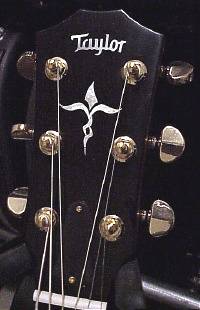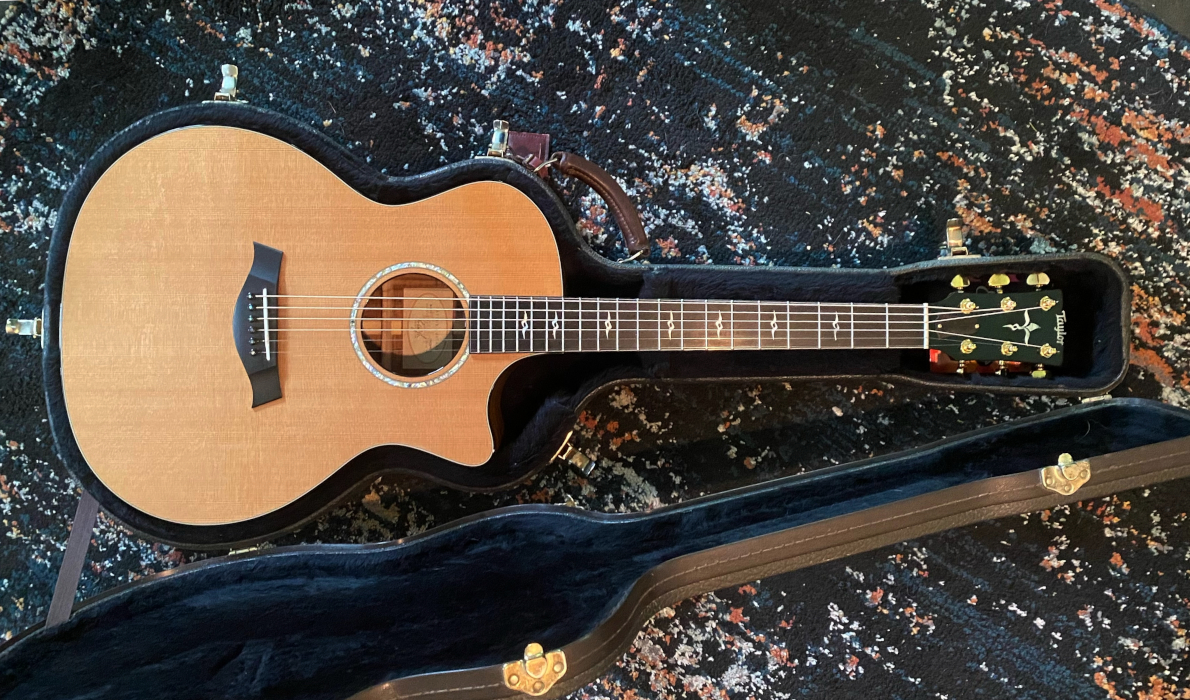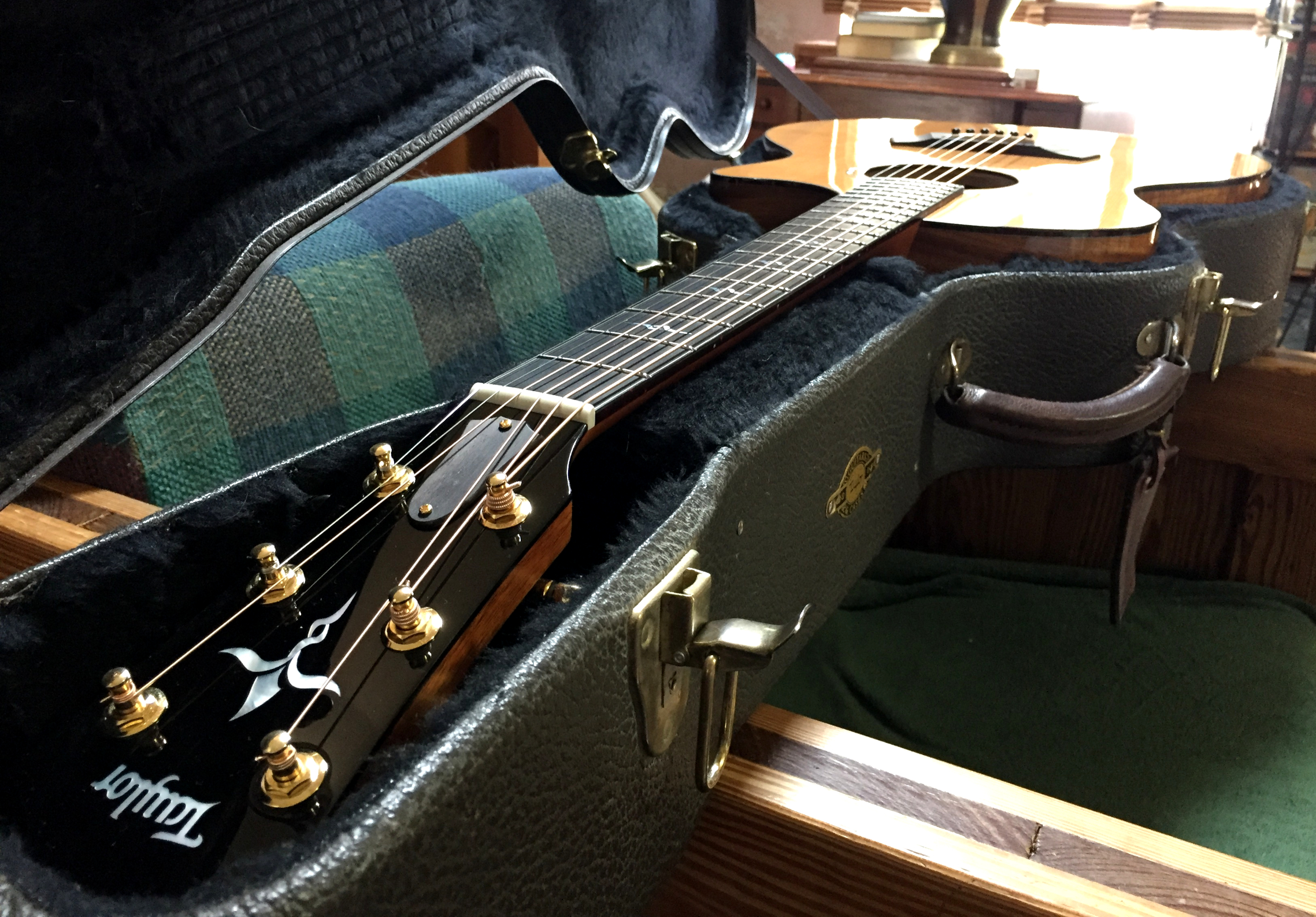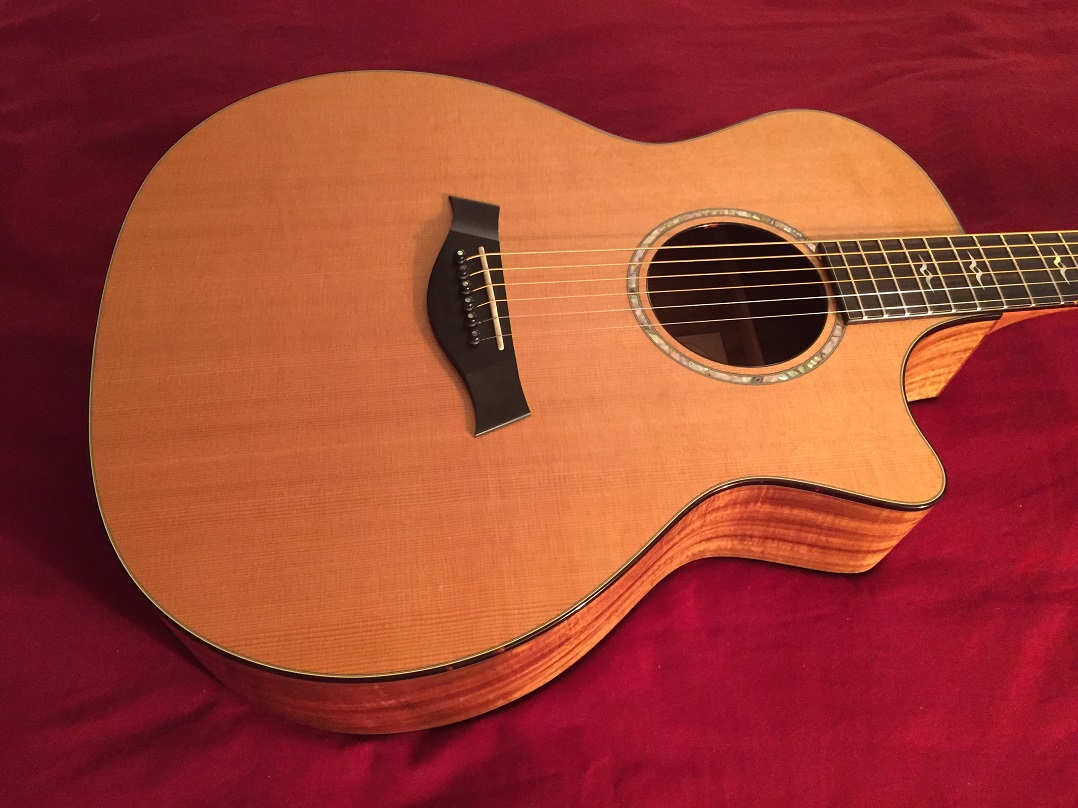The Prodigal Guitar

Or, Now the Story Can Be told...
Or, The Extended Travels of a Taylor K14c...
Or, How Everyone Involved tried to do Everything Right but Still We Suffered the "Slings and Arrows of Outrageous Fortune."
07/04/2023
This is the strange odyssey of a particular guitar of mine, a special guitar in more ways than one. The recent series of events surrounding it has proven to be quite the emotional rollercoaster, including alternating moments of excitement and disappointment. But let's go back to the beginning, shall we? This guitar, a Taylor K14c with a cedar top and Hawaiian koa back and sides, had an interesting beginning because it was first laid down on Taylor's bench on December 14th, 1999. That was Taylor's last day of operations on the last year of the twentieth century. At the end of that day, Taylor shut down the plant and took their customary two-week Christmas holiday leave through the beginning of the new year... and the new century.
1999 was also the year that Taylor began transitioning to their "New Technology" or "NT" neck, starting on what was their lowest range, then the 300 Series and working upwards to their premium lines. That year I was introduced to Taylor Guitars when Amy Grant came into my studio with her 912ce. I was impressed with the fit and finish and sound of the guitar and by the way it filled up the studio. On my next day off I went down to a local dealer who had ALL of their models and played every model in the Taylor line. The K14c jumped out as the one that seemed to best suit my style to both my wife and myself.
I began reading Taylor's literature and heard about the upcoming NT neck transition. As I watched Taylor work their way up the series, I eventually started calling them and asking when the change would hit the Koa series. "Soon," I was told, so my wife and I began getting our finances together. For our twentieth anniversary, I would give her a lovely diamond ring and she would give me my dream acoustic. Finally, one of my calls to Taylor revealed that they had started two K14cs with the old-style neck on the last day of production of 1999 and they were to be the last of the breed. I had a choice of a two-piece back or a three-piece back. I chose the two-piece back guitar and put in my special order.
The guitar arrived and was wonderful, light and lively. I had it set up by my tech and friend Kenny Marshall so it played great. I played it on studio sessions and at home and kept it in pristine condition. This was my most personal guitar; the one I played when I was alone and playing for myself; the one I played for comfort when a friend died; the one I played alone by candlelight during a power outage while waiting for a hurricane to pass. It was my first really good acoustic guitar
SOJOURN #1
Many years later, as eventually happens over the life of an instrument, the guitar's frets began to wear. Fast-forward twenty years and it was becoming hard to stop the strings without buzz. But by that time the world was sheltering in place due to COVID so I couldn't take it in for a refret. I spent the time saving my pesos for a big maintenance trip. After the world opened back up, on May 23rd of 2022, I finally was able to take several guitars that needed work across the Chesapeake Bay to Kenny. More about that, HERE. Kenny has been maintaining my guitars for decades and always does a fantastic job. For this guitar I chose medium stainless steel frets. I chose the medium fret size was to match the original design. As he was evaluating the guitar, Kenny smiled a wry smile and said, "Did this guitar always sound this good? I think this is the best sounding Taylor I've ever played." That was nice, coming from a diehard Martin lover.
Kenny went right to work on my four setups and this refret. On June 10th, the day before I was scheduled to pick them all up, he gave me a call: "I've got kind of bad news." That day he had finished the refret and was putting things back together. To protect everything during the work, Kenny had removed the nut and tuning keys and had masked everything with low-tack tape. At the end of the job, as he removed the tape from the headstock, part of the finish on the front of the headstock delaminated and pulled up with the tape. Over thousands of guitars, this had never happened to him. He tried everything to restore the finish, but it always left a "witness line" and that wasn't good enough for Kenny. I remembered that when this guitar was made, Taylor was experiencing some finish issues. I suggested we ask Taylor if they would handle it as a warranty claim. They graciously agreed to handle it under warranty. However, at that point, they were backed up so far that they couldn't get to it for nearly a half-year. Kenny asked if there was a Taylor-certified Gold-Level repair house that could fit us in more quickly and they suggested an authorized luthier in my region. For this narrative I will call him "Fred" because I don't want to throw any shade on him, and you will see why presently. After finding that that he could, indeed, slide us in immediately, Kenny boxed up my guitar and shipped it the four hundred miles to his shop. Suddenly, things became complicated.
SOJOURN #2
The day after the guitar arrived, Fred posted an apology to his clients on Facebook, saying that he was in the hospital recovering from pneumonia and that his timetable would have to be shifted back until he could be discharged and recover. Wow, that's a tough hit for him in these days of COVID, so I sent a message telling him I hoped and prayed he recovered well. A month later Fred posted on Facebook, saying that in the hospital he had been diagnosed with congestive heart failure. He needed to recover from the pneumonia and begin getting ready for open-heart surgery. Hoo, boy! I was missing my guitar but, darn, Fred was in a bad way. I redoubled my prayers. At the end of August, he went in for surgery.
In October I checked in by email. Fred was beginning to mend, but honestly, was still struggling. He was hoping to get back on a roll "soon." This didn't surprise me that much because open heart surgery is no small affair and often requires a long recuperation period.
On February 8th of 2023 I checked in by text. Fred's heart was 100% but his sternum, which had been cut apart during surgery to get access to his heart, wasn't fusing. Physical activity still wasn't possible and there was a good chance he'd have to go back in for further surgery. More prayer. I checked in with Taylor Guitars. They were aware of Fred's plight and stood behind him as a serviceman. That was a relief. Any anxiety that I felt paled in comparison to the pain, discomfort, displacement, and loss of income that Fred was experiencing. Whatever patience I mustered came easily when I considered Fred's lot.
Then, on April 20th, I received pictures of my guitar's work in process:
On May 13th I received a text and a photo from Kenny showing that the guitar had arrived at his shop, was reassembled, and was ready for me to pick up. Yahoo!!!

So, on May 15th, my wife and I made the trek across the Chesapeake Bay to pick up the Taylor and drop off another guitar, a Martin HD-28, for a setup and fret dressing. I spent a pleasant two hours with Kenny, catching up on his family and business, trying out the K14c, and discussing the next job. While we were there I counted thirty guitars in the shop for work. It is good to see his business, which works entirely on a word-of-mouth basis, thriving! It is also a pleasure to watch a man like Kenny, who really knows what he is doing, evaluate a guitar.
Once I got the guitar into my hands, I was amazed to remember just how comfortable and familiar the guitar felt. It is extremely responsive, a gentle-voiced instrument with a smooth midrange. It is also extremely light and vibrant, and every note comes through the back to your body. It doesn't offer a huge bass response nor is it tremendously loud. Someone has called the model an "intimate" guitar, and I agree. It brings out the best in quiet fingerstyle playing. On the K14c, the medium stainless frets I chose don't stand out as either small or large. Goldilocks would be happy: they turned out to be just kind of right for that neck. Kenny's refret was spectacular - impressive by its transparency and comfort. He asked if I could hear a difference between the former nickel steel fret wire and the stainless I chose. I'll fill in more about that later. Somewhere along the way, Kenny made a cryptic comment about possibly needing to contact Taylor to see about getting the guitar refinished.
The next day I pulled the guitar out to play it again and saw it for the first time in the light of day. I immediately noticed that the guitar's top was covered in what looked like tiny, hard specks of finish overspray, firmly adhered and forming a texture. No amount of polishing with Taylor's preferred Smith's Polish would remove them and I wasn't about to go any further than that. There was a bubble in the headstock finish. There were also scratches on the headstock and body as well as finish delamination on the neck heel. With great disappointment I called Taylor customer service and discussed with them the situation. Their representative cheerfully invited me to send the guitar to the factory for them to handle all the issues. The rep predicted that it would take eight weeks to fix the guitar but said they would try to expedite things because I had waited so long already. He immediately emailed me a prepaid shipping label.
SOJOURN #3
And so, on May 16th, a new chapter in the saga began. Guitar Center kindly provided me with a Taylor Guitars shipping box and my wife and I spent the evening packing up the guitar. The resultant package was like a tank - tight and tough. I placed a folded letter under the strings on the fingerboard respectfully detailing the discrepancies I found. On May 18th I shipped the package and followed the shipment via UPS. So, on May 23rd, twenty-three years and four months after it left, the guitar completed the trek all the way across the continent and returned to the factory where it was built. It was logged in as having "no signs of shipping damage." Let the healing begin.
On Friday, May 26th Chris Bearden at Taylor repairs called and left a voicemail acknowledging each of the discrepancies I listed on the sheet, telling me that they would address each, and giving me a timeline. They said they'd try to get back to me by the end of June.
On June 9th I called and left a request with Chris for a pic or two of the guitar while it was at the plant. In reply, on June 12th, I received two pics of the body at the plant and on June 13th I received another pair of pictures of the finished neck and headstock after it returned from production finishing. I found the process shots fascinating. In the neck shots it looked fantastic, and my excitement grew.
Back and sides scuffed and overcoated, ready for buffing
Top with droplets removed, ready for buffing
Headstock finished
Neck finished
On Monday, June 26th, Andre Casey from Taylor Customer Service called to tell me that the work was complete. He checked my shipping address and sent me a tracking number and a copy of the work order detailing the work they'd done. The work order stated that they had reset the neck while they had it off. I assume they just kindly decided to take care of that as well. The next morning the guitar showed on UPS with a delivery date of Friday, June 29th. During transit there were nearly zero tracking updates, so, fighting excitement after all the ups and downs, I waited.
On delivery morning, Friday, June 29th, UPS reported that it was in town but there had been a delay due to the regional trailer arriving late. As a result, delivery would require an additional business day, but that meant from Friday to Monday. Ironically, the guitar was in the UPS warehouse by the airport near me. UPS customer service said that there was no way to pick it up and save time. Shoot. Three more days.
So at 3pm, on Monday July 3rd, a year and a month after the odyssey began, the package arrived. The UPS guy was a guitarist and enthusiast and wanted to know what guitar I had "bought." I gave him a short version of this story and then he was off. Because it was 98' and humid outside I left the guitar in the shipping box for a while to allow it to cool down. Two hours later I opened the box and reached inside. The case was nearly at our home temperature, maybe a couple of degrees higher. I pulled out the case and decided to go ahead and open it up. The guitar was also near ambient temperature, so I removed it from the case. There was a squeak as it came out because of the new finish! The strings had dropped down about a half-step in transit so I pulled out my phone tuner and brought them up to pitch.
Then I took the time to give it a once-over. The finish is spectacular! The headstock, back and sides, and neck look absolutely new. The headstock especially just glows around the Koa Series inlay. Because they didn't want to load up the top with a respray, the top wasn't oversprayed but was buffed out after the specs were removed and it looks as good as it would in a guitar store. The action is 2/64ths inch at the first fret and 5/64ths at the 12th, with a bit too much relief in the neck. I suspect that the difference in humidity between the factory and Virginia has affected things a bit. No problem: that can easily be taken care of. Sighting down the neck I can see that the neck-to-bridge geometry is correct again because of the reset. There is a tiny bit of fingerboard fall-off after the neck joins the body, making me think they reset the neck angle by sanding off just a tiny bit of the neck heel. That is the normal technique for resetting a bolt-neck guitar.
If you remember, Kenny asked me whether I heard any difference with the stainless frets. After giving it a little time, I have detected a little "zing" across the upper strings that wasn't there before, perhaps an amount you'd expect from rosewood. The guitar sounds just a tiny bit brighter than it did with the original nickel frets, enough so that my wife noticed. Perhaps some of that can be attributed to Taylor's move to D'Addario coated strings. In this case that is a good thing. Originally, the guitar might have been accused of being a little bit too round and emphasizing the fundamentals too much and in fact, a friend once said exactly that. It now has a tad bit more high-end articulation. I chose stainless for that very reason, and it paid off.
I texted the good news to my luthier, Kenny, and he invited me to bring it by for him to look at once it settled in. So a few days later on July 9th, we made the trek across the bay and spent a pleasant couple of hours discussing music, guitars, and people, while Kenny brought the guitar's action back into his spec. It feels spectacular! There really wasn't that much to do because he had done the main work at refret time. He did comment again that the guitar was wonderful sounding. While there, I counted forty-three instruments in his shop for work! Yay for Kenny!
Meanwhile, in a fun correlation, the prodigal guitar has arrived back home just in time to celebrate the event it was originally acquired to celebrate, my lovely wife's and my anniversary. Only this time, twenty-three years later, it will be there as we celebrate our forty-third anniversary! A big thank-you to Kenny and Taylor for rejuvenating this guitar and to my wife for giving it to me!

Home and dry

UPDATE I sent a link to this story to the guys in repair and they really seemed to appreciate the little bit of encouragement I sent their way. I guess we ought to remember to thank the folks behind the scenes more often, eh? I don't know why it surprises me: that's the way my career works as well.
= =
=




